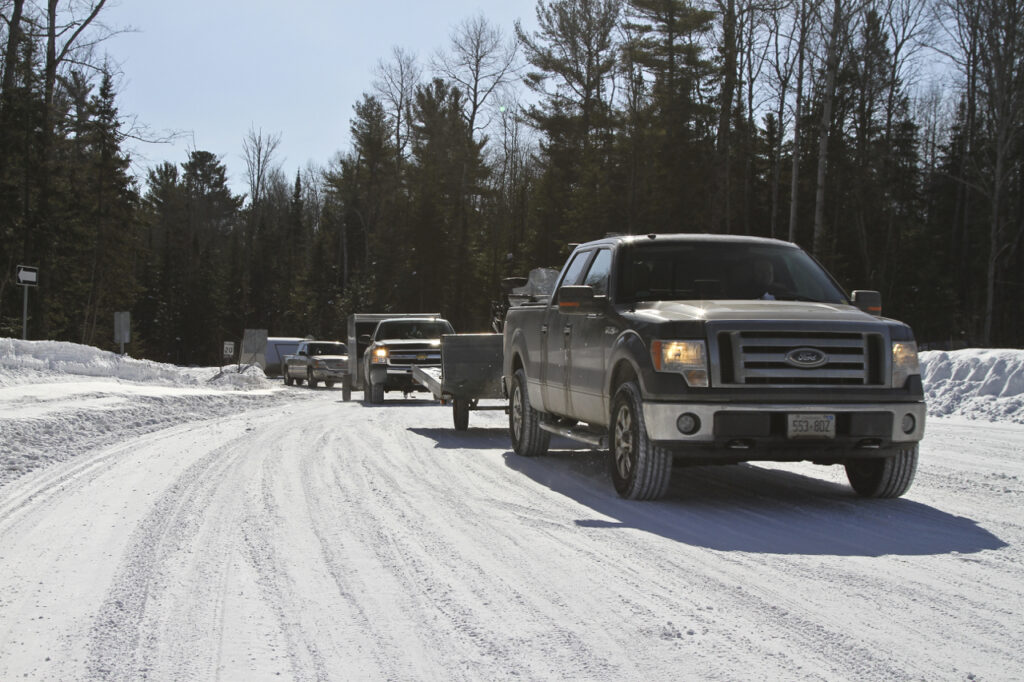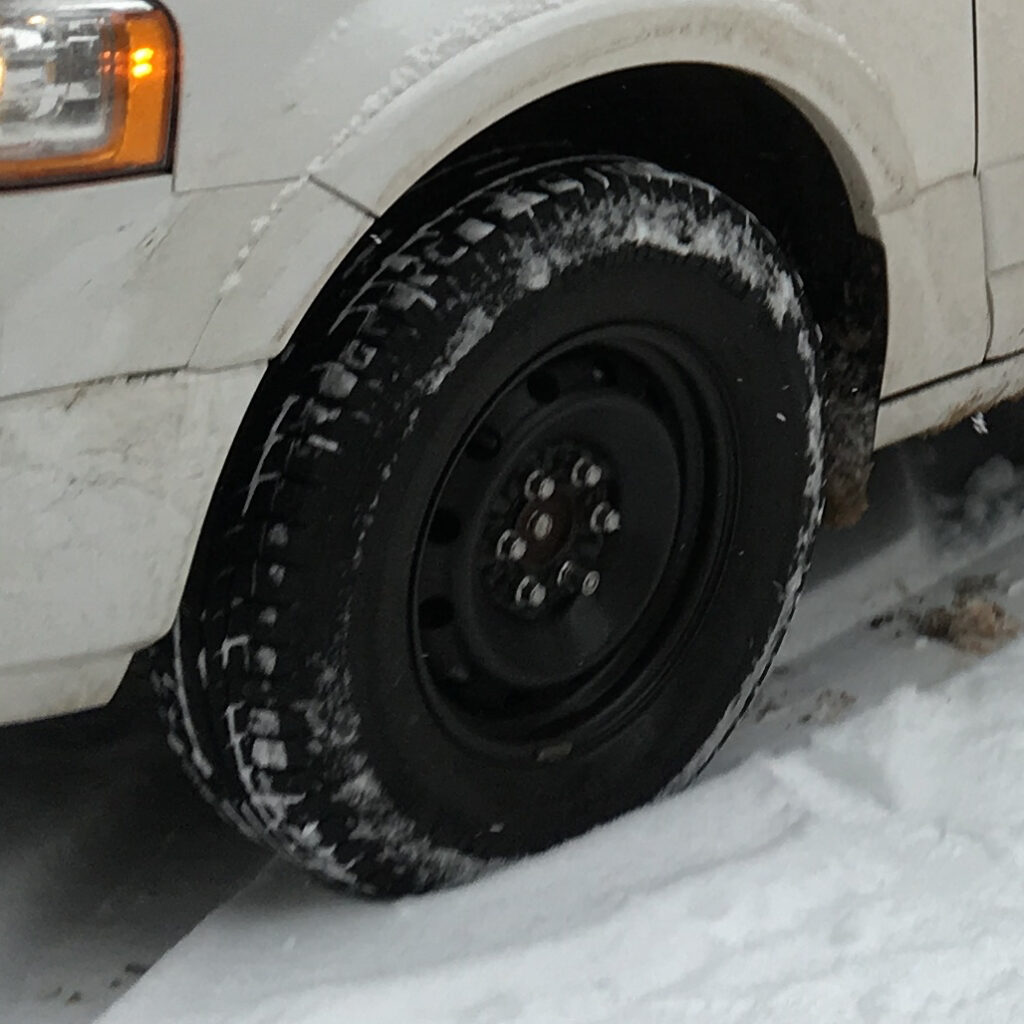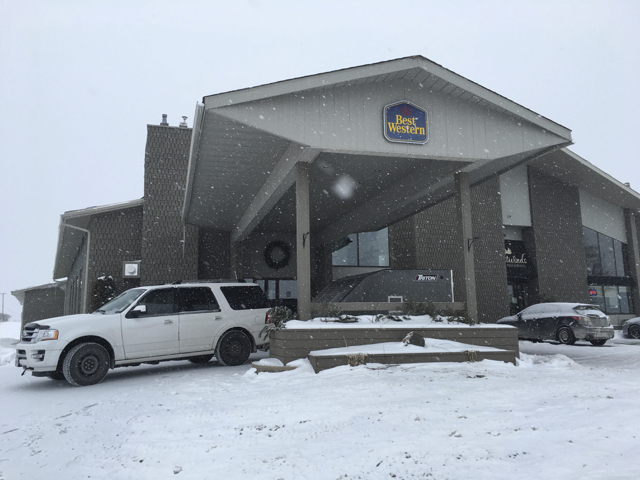Winter Tires Make Trailering Safer…
Related: Best Tow Vehicle Tips
How much attention do snowmobilers pay to tow vehicle winter tires? Maybe not enough…
Changing Travel Patterns
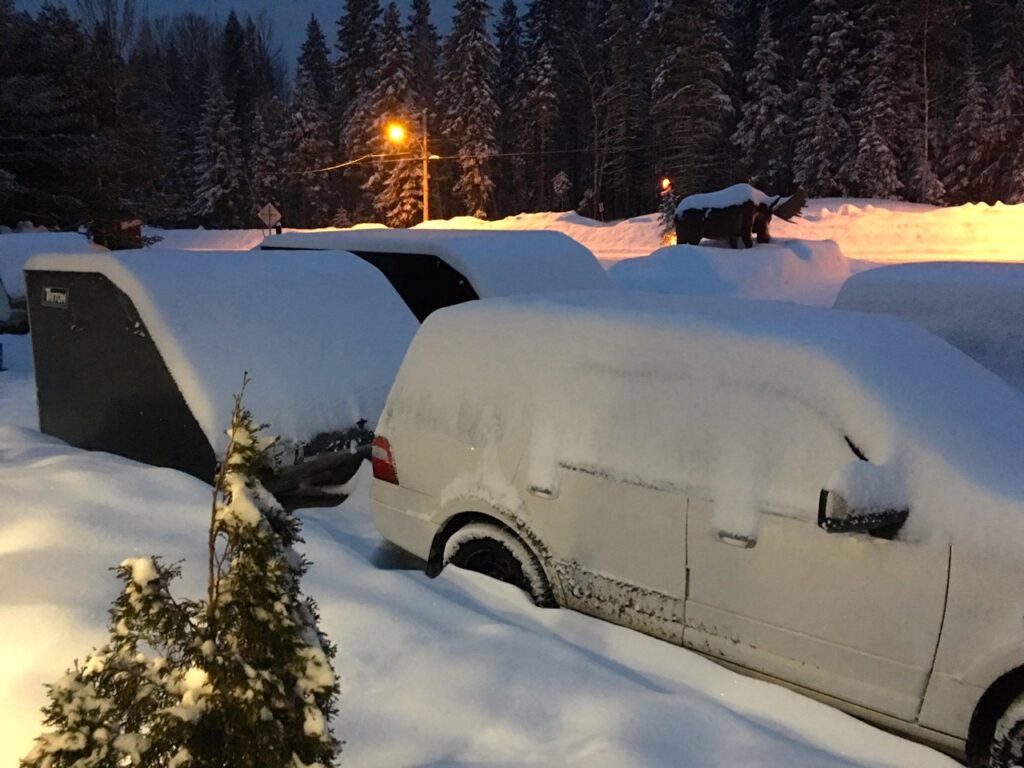
Tow vehicle winter tires provide extra traction for starting up in deep snow. Photo © by Craig Nicholson
It used to be that many snowmobilers could trail ride from home, so towing and trailering wasn’t much of a consideration. But today, the snow line may have moved farther away. Also, more of us are urbanites who reside far from the nearest trail. Additionally, we do more destination touring. This desire to explore new places often necessitates trailering our snow machines.
So as well as acquiring bigger and better snowmobile trailers, pick up trucks and SUV’s are the tow vehicles of choice. Of course, unlike our sleds and trailers, which we often store for the off seasons, we use our tow vehicles all year long.
Winterizing Tow Vehicles
One result is year round wear and tear. Another is a tendency to take for granted this primary vehicle that we’re so accustomed to. So unlike the special attention we bestow on our snowmobiles and trailers in preparation for the snowy season, we often neglect “winterizing” our tow vehicles.
Not being mechanically inclined, I take my Ford Expedition SUV to my dealer for all regularly scheduled service. Most important from a snowmobiling perspective, my Expedition goes in for a special winter service late every fall. I make sure my service advisor knows and understands that I’ll be doing a lot of winter driving, mostly while towing my Triton snowmobile trailer. This helps ensure that my SUV is as winter ready as possible, including switching to tow vehicle winter tires.
Buying Tow Vehicle Winter Tires

My previous SUV tow vehicle & Triton Trailer with tow vehicle winter tires. Photo © by Craig Nicholson.
Perhaps the most confusing and overlooked aspect of prepping your tow vehicle for the snowy season is tires. First, what type should you choose? All season, all weather or winter tires? Second, which one among a variety of brands is most suitable for snowmobile trailering? Third, how do you know what size and width to get? Finally, is the perfect tire actually available for your tow vehicle? And if so, is it still in stock by the time you decide to go tire shopping?
Why Choose Tow Vehicle Winter Tires
I’m no tire expert. So don’t expect me to recommend a winter tire brand in this article. My purpose here is to overview why I believe winter tires make towing safer, not to do a product review. But I’ve experienced some pretty hairy driving conditions while snowmobile trailering tens of thousands of kilometres over the years. So if there’s one thing I’ve learned, it’s that when it comes to superior control and stopability, don’t scrimp on your tow vehicle tires.
Why? Because you need all the help you can get when there’s a loaded snowmobile trailer behind you. A trailer that can change your whole driving equation in an instant. Plus, my search for snow has led me into some tricky situations where getting stuck was a serious probability. Good winter tires can give you an extra edge when it’s most urgently needed. It all comes down to traction. That’s a function of a tire’s ability to cut through snow and get a better grip on slippery surfaces. And that’s why I choose the best winter tires I can find.
How Winter Tires Work
Winter tires are designed for the best possible traction in the harshest winter conditions. Apparently, manufacturers make them with rubber compounds that remain soft(er) than any other type of tire below 7˚C (45˚F). Meanwhile, other tires types start to harden and gradually lose their grip when the mercury drops below this magic number. So winter tires deliver superior traction in winter conditions, and even provide reasonable grip on ice. This advantage is also thanks to heavier siping (thin slits cut across the rubber surface) and deep circumferential grooves (deep grooves molded in the tread pattern). The deeper the better for best traction. Together, they work to expel snow and slush build up. Studded winter tires are even better, but are illegal in many jurisdictions.
How To Check Winter Tires
If you use a tire service or garage to switch your tires seasonally, be sure they give you a report on the condition of the tires coming off. That way, if you need new ones, you can plan ahead to buy them on sale. Alternatively, if you switch your own tires, here are some tips for checking wear.
Suggested Dates To Switch to Tow Vehicle Winter Tires
Based on Canadian average temperature stats, here are the likely dates by which temperatures may fall consistently below the 7˚C (45˚F) mark for installing winter tires. As they say, if you can see your breath, it’s time to get winter tires!
Quebec
- Montreal: November 10
- Quebec City, Gatineau and Sherbrooke: November 5
- Rimouski and Gaspé: October 30
- Sept-Îles: October 20
- Val-d’Or and Saguenay: October 25
Maritimes
- Charlottetown: November 10
- Fredericton: November 9
- Halifax: November 12
- Moncton: November 10
- Saint John: November 7
- Sydney: November 12
Ontario
- Kingston: November 11
- Ottawa: November 9
- Sudbury: November 2
- Timmins: October 26
- Thunder Bay: November 1
- Toronto: November 15
- Windsor: November 21
West and Prairies
- Edmonton: October 28
- Kelowna: November 9
- Prince Rupert: November 16
- Regina: October 29
- Saskatoon: October 27
- Vancouver: December 11
- Victoria: December 17
- Winnipeg: October 30
Winter Driving Advice
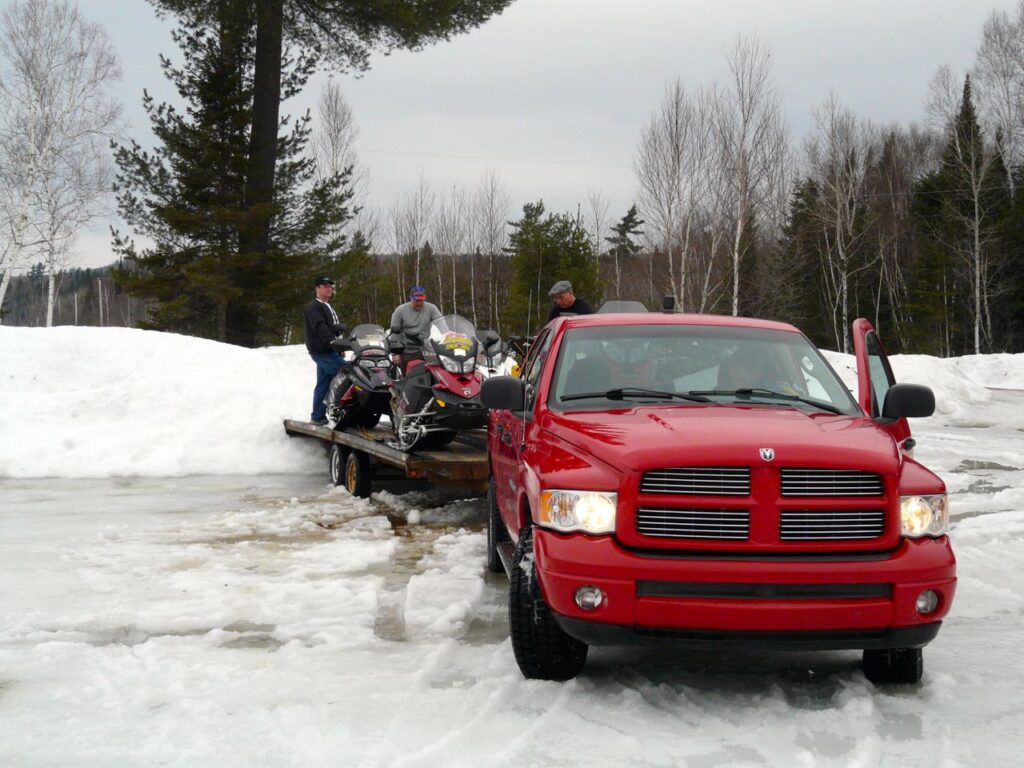
Tow vehicle winter tires give superior traction in slushy, icy conditions. Photo © by Craig Nicholson
Certainly, tow vehicle winter tires can make snowmobile trailering safer. But they can also lead to driver over confidence. Ultimately, they cannot compensate for not driving according to road conditions, such driving too fast and making sudden manoeuvres. Or towing an over loaded trailer. Or one with too much tongue weight. And remember, your snowmobile trailers doesn’t have winter tires. So your traction depends on how your tow vehicle is equipped.
Finally, don’t expect much help while driving from all-wheel or 4WD. Both can be helpful to get a vehicle moving in snow or ice and for travelling stability, but are less beneficial while trying to stop more quickly. Or if you’ve already lost control.
7 Tow Vehicle Winter Tire Tips
Here are a couple of other tips about tow vehicle winter tires.
Tip 1
I found it much more convenient to leave mine mounted permanently on plain steel rims. This way, winter and summer tires are both on their own rims for easier between season changes. Doing so also prevents my expensive summer rims from being damaged by corrosive winter road conditions.
Tip 2
Storing tires is cumbersome and space consuming. To say nothing of heavy! So I pay my dealer to keep them for me.
Tip 3
I installed wheel nut locks to discourage tire thieves when my SUV and trailer are parked unattended for any length of time.
Tip 4
Be careful not to change to winter tires too early or keep them on too late. Their softer rubber compound wears more while driving in temperatures over 7˚C (45˚F). This can significantly decrease winter tire life expectancy.
Tip 5
Always install four winters tires. If they’re only on the front, there’s danger of oversteering when rear wheels lose grip. Alternatively, winters on the back only can result in understeering, when front tirs don’t grip as expected.
Tip 6
Check your tire pressure more often in the winter. Do so because colder temperatures can change your pressure considerably. And lower pressure can interfere with winter steering and stopping.
Tip 7
Finally, check your winter tires annually to make sure they are still in good condition. I’ve found the best time to do this is when they come off each spring. This way, I know whether or not I have to budget for new winter tires and can shop early next fall for the best price and selection
Learning The Hard Way
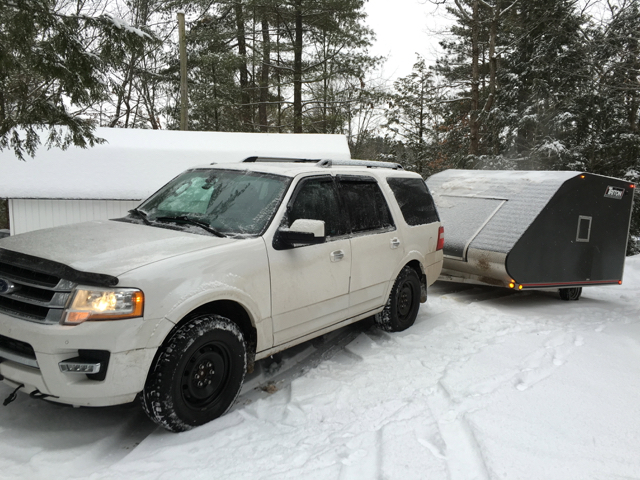
My rig survived a detour into the ditch thanks to tow vehicle winter tires. Photo © by Craig Nicholson
Now it’s time for full disclosure. I learned the hard way about the limitations of winter tires and high tech vehicle traction. I was driving along a four-lane divided expressway in the right lane. I’d been going faster. But I had slowed down for the last several kilometres because the surface seemed to be getting slippery. Suddenly, with no warning or no abrupt move on my part, my tow vehicle headed off the highway as if it had a mind of its own. It shot across the shoulder and into the rhubarb. I had absolutely no control and went at least 100 feet off the road before coming to a stop buried in deep snow.
Fortunately, the roadside was relatively flat and wide, with no trees of rocks. So we didn’t flip over or do any damage. What’s more, my trailer followed straight in behind without making a bad situation worse by also going out of control. And my Tie Boss Tie Downs kept my sleds from moving at all.
As I sat behind the wheel, stuffing my heart back down my throat and changing my shorts, I figured we’d be a while getting out. But a very skilled tow ruck driver had us winched out quickly with the help of my Expedition’s 4WD-L and good traction form my tow vehicle winter tires.
My Last Word
Looking back, I realize that this incident could have been much worse. But I’m grateful that including my Expedition in my get-ready-for-winter preparations paid off big time. Doing so certainly saved my sledding season and possibly, my life. What’s yours worth?
For more, check out this winter tire review from the Automotive Protection Association.
The tips and advice in this blog are the opinions of the author, may not work in every situation and are intended only for the convenience and interest of the reader, who has the personal responsibility to confirm the validity, accuracy and relevancy of this information prior to putting it to their own use.

